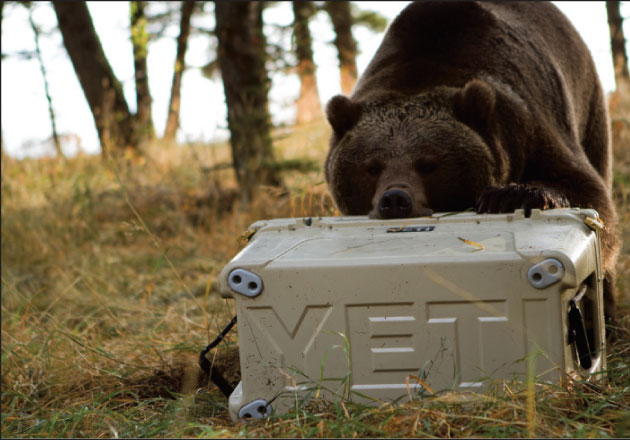If you believe in quality products, than Yeti is a cooling system worth a look. They’re unrivaled in their ability to keep ice from melting and retain coolness. With two inches of polyurethane foam insulation, freezer-style gaskets, and a positive lid-latching system, the unit really insulates. Yetis are built for years of use with marine-quality fittings; they’re constructed of food-grade materials, are dry-ice compatible, and boast heavy-duty hinges and handles. Best of all, the drain plug is guaranteed leak-proof. Whether you opt for a high-end cooler or a less expensive model, a quality cooler should be a cornerstone of your outdoor experience. They can be far more than an “ice box,” as these ten tips suggest:
Gear Storage: I once turkey hunted in Texas with a dozen other hunters, and we all slept in one large room. Anticipating success, I brought a cooler and quickly found that storing my gear in the cooler helped to keep things from getting mixed up and sticky fingers from borrowing my calls and shells.
slept in one large room. Anticipating success, I brought a cooler and quickly found that storing my gear in the cooler helped to keep things from getting mixed up and sticky fingers from borrowing my calls and shells.
Flying Gear: If you’ll need a cooler to store food on a hunting or fishing trip, use it as a suitcase. Buy a locking strap at a local travel store and tape the top shut. If you’re lucky, you can bring the cooler home filled with steaks or fillets and ship your lighter gear, saving you hundreds.
 Protect From Freezing: In cold weather, a cooler can be used to keep water bottles, eggs, and other perishables from freezing. Just remember to close the lid tightly at night.
Protect From Freezing: In cold weather, a cooler can be used to keep water bottles, eggs, and other perishables from freezing. Just remember to close the lid tightly at night.
Buy Local and Save: I’m hunting elk in Colorado this fall, and we’ll buy all of our food (except eggs, milk, and bread) ahead of time. We leave with meats and other perishables solidly frozen and they’ll still be stiff when we arrive in camp two days later. This way, we can feast on our favorite foods and know they’ll be available at a reasonable price. We pack coolers full of food and plan on filling the empty space with elk on the return trip.
Cook and Serve: Another camp I hunt from has lots of visitors; we handle the hungry crowds by cooking large casseroles of grub in aluminum pans back home, freezing them solidly, and storing them in coolers. We label each dish with contents and have warm meals ready when everyone comes in for dinner after the hunt.
Dry Ice Refresher: On long stays, a little dry ice goes a long way. In the West, most grocery stores carry dry ice. Five pounds will really put the chill back into your food and extend any refrigeration loss.
 Buy on the Fly: Sometimes the baggage fees for flying a cooler doesn’t make sense, so why not buy one at your destination? In this case, you may want to seek out a bargain. The money saved, coupled with the convenience of having a cooler with you, will mean that the cooler more than pays for itself. Before flying home, donate the cooler to Goodwill or the Salvation Army.
Buy on the Fly: Sometimes the baggage fees for flying a cooler doesn’t make sense, so why not buy one at your destination? In this case, you may want to seek out a bargain. The money saved, coupled with the convenience of having a cooler with you, will mean that the cooler more than pays for itself. Before flying home, donate the cooler to Goodwill or the Salvation Army.
Chill Before Freezing? This trick may work on Thermos bottles, but the opposite helps with coolers. To keep your coffee hot on a really cold day, pour hot water into the Thermos and allow the liner to warm up before adding the coffee. Conversely, put ice in your cooler before you fill it. Allow the ice to chill the liner and then fill it with frozen or perishable goods.
Fill ‘Er Up: Since we pump our own gas, we don’t use this expression very often, yet a cooler filled with ice or frozen food will insulate better than one half-filled. If you have several coolers, combine all the frozen material in one cooler to reduce the air space as much as possible.
Think Mobility: It’s easy to overpack large coolers and hurt yourself when lifting or loading. Models with wheels and padded handles make moving heavy objects much easier. A quality cooler can quickly pay for itself by eliminating food spoilage and can help to make any trip in the outdoors more fun.
Tell us what you think in the comments section below.



















![The Best Deer Camp Chili [VIDEO] Deer Chili Ingredients, Tomatoes, Chili Spices](/wp-content/uploads/2015/10/Deer-Chili-Deer-Camp-Recipe-218x150.jpg)
![How to Call Elk Early in the Season [VIDEO]](/wp-content/uploads/2016/08/byers003-218x150.jpg)




![Idiots Disturb Hunter: How Would You Have Handled It? [VIDEO]](/wp-content/uploads/2015/10/DSC00110-e1474487693878-100x70.jpg)
![Albino Buck Shocked to Shed His Antlers [VIDEO]](/wp-content/uploads/2015/10/AlbinoDeer-100x70.jpg)